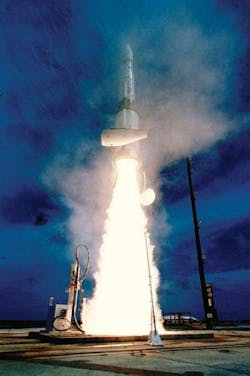Boeing, Missile Defense Agency test missile defense sensor integration and netcentricity
By Courtney E. Howard
ST. LOUIS—Engineers with The Boeing Company in St. Louis and the U.S. Missile Defense Agency, together with industry teammates, completed testing of a Ground-based Midcourse Defense (GMD) system being billed as “the most complex integration to date of sensors required to support a missile intercept,” officials say.
This event surpassed previous single-sensor tests of the GMD system, incorporating four target-tracking sensors: the Aegis Long Range Surveillance and Track system in the Pacific; the AN/TPY-2 radar in Juneau, Alaska; the Upgraded Early Warning Radar at Beale Air Force Base, Calif.; and the Sea-Based X-Band Radar (SBX) in the Pacific. These four sensors were used not only to detect, but also to track and assess a long-range ballistic missile target that was launched from the Kodiak Launch Complex in Alaska.
The integrated sensors transmitted target information via ground and satellite links to GMD’s dual-node, distributed fire-control system at Fort Greely, Alaska, and in Colorado Springs, Colo. The fire-control system combined all the gathered sensor data to generate targeting coordinates. The target shoot-down was simulated with a virtual ground-based interceptor.
“This test verified that four sensors separated by thousands of miles can detect, track, and provide precise trajectory information to help defend against a long-range ballistic missile attack,” says Scott Fancher, vice president and general manager of Boeing Missile Defense Systems.”
“This test demonstrated GMD’s network-centric ability to use data gathered from multiple, global sensors to give us a clearer picture of an incoming threat and greatly increase our ability to intercept that threat,” adds Greg Hyslop, vice president and program director for GMD.
The GMD system is reportedly the first missile defense program to be deployed operationally to defend the U.S. against ballistic missile attacks, and it is considered the nation’s only defense against long-range ballistic missiles.
GMD integrates sensors, command-and-control facilities, communications terminals, a 20,000-mile fiber-optic communications network, and interceptors in underground silos at Fort Greely and Vandenberg Air Force Base, Calif.
Boeing serves as the prime contractor for GMD, working with industry partners Raytheon Company in Waltham, Mass.; Orbital Sciences Corp. in Dulles, Va.; Northrop Grumman Corp. in Herndon, Va.; Bechtel in Frederick, Md.; and Teledyne Brown Engineering in Huntsville, Ala.
For more information, visit Boeing Integrated Defense Systems, a division of The Boeing Company, online at www.boeing.com/ids.



